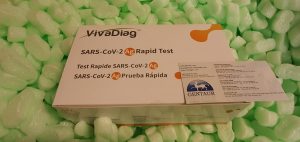Genetic and biological characterisation of three cryptic Eimeria operational taxonomic units that infect chickens (Gallus gallus domesticus)
More than 68 billion chickens have been produced globally in 2018, emphasising their main contribution to the manufacturing of protein for human consumption, and the significance of their pathogens. Protozoan Eimeria spp. are probably the most economically important parasites of chickens, incurring international prices of greater than UK £10.four billion each year. Seven Eimeria spp. have lengthy been recognised to infect chickens, with three extra cryptic operational taxonomic units (OTUs) first described greater than 10 years in the past. As the world’s farmers try to cut back reliance on routine use of antimicrobials in livestock manufacturing, changing medication that goal a variety of microbes with exact species- and typically strain-specific vaccines, the breakthrough of cryptic genetic sorts can pose critical issues.
Consideration of biological traits together with oocyst morphology, pathology brought on throughout an infection and pre-patent durations, mixed with gene-coding sequences predicted from draft genome sequence assemblies, counsel that all three of these cryptic Eimeria OTUs possess adequate genetic and biological range to be thought of as new and distinct species. The means of these OTUs to compromise rooster body weight acquire and escape immunity induced by present commercially accessible anticoccidial vaccines signifies that they might pose a notable menace to rooster well being, welfare, and productiveness.
We counsel the names Eimeria lata n. sp., Eimeria nagambie n. sp. and Eimeria zaria n. sp. for OTUs x, y and z, respectively, reflecting their look (x) or the origins of the primary isolates of these novel species (y, z). The Cas9 transgenic animals will present a strong useful resource for in vivo genome enhancing for each agricultural and translational biomedical analysis, and will facilitate reverse genetics in addition to cross-species comparisons.
Recovery of Recombinant Avian Paramyxovirus Type-3 Strain Wisconsin by Reverse Genetics and Its Evaluation as a Vaccine Vector for Chickens
A reverse genetic system for avian paramyxovirus type-3 (APMV-3) pressure Wisconsin was created and the infectious virus was recovered from a plasmid-based viral antigenomic cDNA. Green fluorescent protein (GFP) gene was cloned into the recombinant APMV-Three genome as a overseas gene. Stable expression of GFP by the recovered virus was confirmed for no less than 10 consecutive passages. APMV-Three pressure Wisconsin was evaluated in opposition to APMV-Three pressure Netherlands and APMV-1 pressure LaSota as a vaccine vector. The three viral vectors expressing
GFP as a overseas protein have been in contrast for degree of GFP expression degree, progress charge in rooster embryo fibroblast (DF-1) cells, and tissue distribution and immunogenicity in particular pathogen-free (SPF) day-old chickens. APMV-Three pressure Netherlands confirmed highest progress charge and GFP expression degree among the many three APMV vectors in vitro. APMV-Three pressure Wisconsin and APMV-1 pressure LaSota vectors have been primarily confined to the trachea after vaccination of day-old SPF chickens with none observable pathogenicity, whereas APMV-Three pressure
Netherlands confirmed large tissue distribution in numerous physique organs (mind, lungs, trachea, and spleen) with delicate observable pathogenicity. In phrases of immunogenicity, each APMV-Three strain-vaccinated teams confirmed HI titers two to three fold larger than that induced by APMV-1 pressure LaSota vaccinated group. This examine gives a novel paramyxovirus vector (APMV-Three pressure Wisconsin) which can be utilized safely for vaccination of younger chickens as a substitute for APMV-1 pressure LaSota vector.

Bacillus amyloliquefaciens TL Downregulates the Ileal Expression of Genes Involved in Immune Responses in Broiler Chickens to Improve Growth Performance
Bacillus amyloliquefaciens TL promotes broiler rooster efficiency by bettering nutrient absorption and utilization and lowering intestinal irritation. In this examine, RNA-sequencing (RNA-seq)-based transcriptomes B. amyloliquefaciens TL, as a feed additive, on the intestine immune operate. In complete, 475 genes have been considerably differentially expressed between the ileum of probiotic-fed and management birds. The expression of genes encoding pyruvate kinase, prothymosin-α, and warmth stress proteins was excessive within the ileum of probiotic-fed birds (FPKM > 500), however not within the management group.
The gene ontology purposeful enrichment and pathway enrichment analyses revealed that the uniquely expressed genes within the management group have been largely concerned in immune responses, whereas these within the probiotic group have been concerned in fibroblast progress issue receptor signaling pathways and constructive regulation of cell proliferation. Bacillus amyloliquefaciens TL downregulated the expression of sure proinflammatory components and affected the cytokine-cytokine receptor interplay pathway. Furthermore, B. amyloliquefaciens TL in broiler diets altered the expression of genes concerned in immune features within the ileum.
[Linking template=”default” type=”products” search=”Recombinant Chicken IFN alpha” header=”3″ limit=”152″ start=”3″ showCatalogNumber=”true” showSize=”true” showSupplier=”true” showPrice=”true” showDescription=”true” showAdditionalInformation=”true” showImage=”true” showSchemaMarkup=”true” imageWidth=”” imageHeight=””]
Research has centered totally on genetically modified mice, though different species like pigs resemble the human physiology extra carefully. In addition, cross-species comparisons with phylogenetically distant species reminiscent of chickens present highly effective insights into basic biological and biomedical processes. One of probably the most versatile genetic strategies relevant throughout species is CRISPR-Cas9. Here, we report the era of transgenic chickens and pigs that constitutively categorical Cas9 in all organs. These animals are wholesome and fertile. Functionality of Cas9 was confirmed in each species for a quantity of totally different goal genes, for a spread of cell sorts and in vivo by focused gene disruption in lymphocytes and the creating mind, and by exact excision of a 12.7-kb DNA fragment within the coronary heart.
Related Posts

Exploring the genetic architecture of feed efficiency traits in chickens

Genetics and breeding of a black-bone and blue eggshell chicken line. 1. Body weight, skin color, and their combined selection

